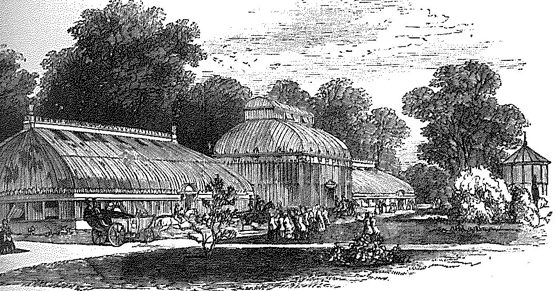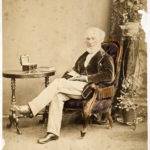Time Line
- 1790 Walter Wade petitioned Parliament for a public botanic garden.
- 1795 The Dublin Society took possession of lands at Glasnevin.
- 1796 Walter Wade appointed Botany Professor.
- 1798 John Underwood appointed Head Gardener.
- 1800 Gardens opened to the public. First glasshouse built.
- 1815 Entrance gates and lodges gifted to the Gardens by Thomas Pleasants.
- 1819 Octagon House built for the Norfolk Island pine.
- 1825 Samuel Litton appointed Professor.
- 1833 Underwood retired.
- 1834 Ninian Niven appointed Curator. New landscape plan for the Gardens.
- 1838 Niven produced Guidebook for the Gardens. Resigned.
- 1838 David Moore appointed Curator.
- 1840 Pampas grass introduced from Argentina.
- 1843 Curvilinear glasshouse started. Mainly the work of Dublin ironmaster, Richard Turner.
- 1845 Orchid seeds germinated for the first time in cultivation. Potato blight noted on 20th August.
- 1848 William Henry Harvey appointed Professor.
- 1848 Abelia triflora introduced from the Himalayas by Edward Madden.
- 1849 Curvilinear House opened. Visit by Queen Victoria.
- 1854 Aquatic House erected for the giant Amazon waterlily.
- 1862 First Palm House built – an unstable, wooden structure which was damaged by gales in 1883.
- 1868 First hybrid pitcher-plant produced -Sarracenia × moorei.
- 1869 Curvilinear Range extended.
- 1878 Gardens handed over to State control.
- 1879 David Moore died, succeeded by his son Frederick.
- 1883 First Palm House blown down; replaced by the present structure.
- 1911 Frederick Moore knighted for services to Horticulture.
- 1915 Assistant Keeper C.F.Ball killed at Gallipoli, Escallonia cultivar named after him.
- 1922 Sir Frederick Moore retired, succeeded by J.W.Besant.
- 1944 Thomas Walsh appointed Keeper/Director.
- 1965 Fern House completed.
- 1968 Thomas Walsh retired. Aidan Brady appointed Director.
- 1970 National Herbarium transferred from the National Museum.
- 1987 Publication of The Brightest Jewel, a history of the National Botanic Gardens, Glasnevin, Dublin, by E.C.Nelson and E.M.McCracken.
- 1992 Transfer of the National Botanic Gardens to the Office of Public Works (OPW). Restoration of Curvilinear Range commenced.
- 1993 Aidan Brady died, succeeded by Donal Synnott.
- 1994 New Alpine House opened.
- 1995 Curvilinear Range (1843) restored. Bicentenary of the founding of the Gardens celebrated. The Great Famine remembered.
- 1995 Heritage functions of OPW transferred to the then Department of Arts, Culture and the Gaeltacht.
- 1997 Dúchas The Heritage Service, Department of Arts, Heritage, Gaeltacht and the Islands established. Kilmacurragh Arboretum in county Wicklow comes under the managment of the National Botanic Gardens.
- 1997 Library / Herbarium completed.
- 1999 New Service Glasshouses commissioned.
- 2000 New Visitor Centre opened.
- 2002 Restoration of Palm House begun.
- 2003 Gardens transferred to Office of Public Works.
- 2004 Donal Synnott retires as Director.
- Restored Palm House (1884) opened.
- 2005 Peter Wyse Jackson appointed as Director.
- 2010 Gardens hosts the 4th Global Botanic Gardens Congress, and Kilmacurragh Arboretum recognised as a Botanic Garden in its own right.
- Teak House (1945) restored and Courtyard Tearooms opened.
- Matthew Jebb appointed as the tenth Director of the Gardens.
In 1790, the Irish Parliament, with the active support of the Speaker of the House, John Foster, granted funds to the Dublin Society (now the Royal Dublin Society), to establish a public botanic garden.
In 1795, the Gardens were founded on lands at Glasnevin. The portrait of John Foster (below right) by William Beechey (1813) in Leinster House shows him sitting at his desk holding a map of the Botanic Gardens. The original purpose of the Gardens was to promote a scientific approach to the study of agriculture. In its early years the Gardens demonstrated plants that were useful for animal and human food and medicine and for dyeing but it also grew plants that promoted an understanding of systematic botany or were simply beautiful or interesting in themselves.
- Walter Wade
- John Foster
By the 1830s, the agricultural purpose of the Gardens had been overtaken by the pursuit of botanical knowledge.
This was facilitated by the arrival of plants from around the world and by closer contact with the great gardens in Britain, notably Kew and Edinburgh and plant importers such as Messrs. Veitch. By 1838, the basic shape of the Gardens had been established. Ninian Niven as Curator had, in four years, laid out the system of roads and paths, and located many of the garden features that are present today.
The ever increasing plant collection, and especially plants from tropical areas, demanded more and more protected growing conditions and it was left to Niven’s successor, David Moore, to develop the glasshouse accommodation. Richard Turner the great Dublin iron-master, had already supplied an iron house to Belfast Gardens, and he persuaded the Royal Dublin Society that such a house would be a better investment than a wooden house. So indeed it has proved.
- Ninian Niven. University of Melbourne Archives
- Richard Turner. Trustees of the Royal Botanic Gardens, Kew
David Moore’s contribution to the Gardens, to its plant collections and to its reputation nationally and internationally is unsurpassed.
His interests and abilities were wide ranging; he had studied the flora of Antrim and Derry, fungi, algae, lichens, bryophytes, ferns and flowering plants, before taking up his post at Glasnevin. While at Glasnevin he developed links with Botanic Gardens in Britain, in Europe and in Australia (his brother Charles became Director at Sydney). Moore used the great interest in plants that existed among the estate owners and owners of large gardens in Ireland to expand trial grounds for rare plants not expected to thrive at Glasnevin. The collections at Kilmacurragh, Headford, and Fota, for example, attest to this.
It was David Moore who first noted potato blight in Ireland at Glasnevin on 20th August 1845, and predicted that the impact on the potato crop would lead to famine in Ireland. He continued to investigate the cause of the blight and correctly identified it as a fungus but narrowly missed finding a remedy. David Moore was succeeded by his son Frederick, who was made Curator at the age of twenty-two. Some of the gardening establishment figures of the day were sceptical that such a young man would be up to the job. Frederick Moore soon justified his appointment and went on to establish Glasnevin as one of the great gardens of the world. In due course he was knighted for his services to horticulture.
- David Moore
- Sir Frederick Moore
The scientific purposes of the Gardens was overshadowed by its horticultural reputation during Frederick Moore’s term of office.
The Scientific Superintendent of the Gardens, William Ramsay McNab, died in 1889 and was not replaced. This hiatus lasted until the appointment of a plant taxonomist, Brian Morley, in 1968 and the transfer of the National Herbarium with two botanists, Maura Scannell and Donal Synnott, from the National Museum in 1970.
- William Ramsay McNab
- Maura Scannell
- Donal Synott
A development plan for the Gardens, published in 1992, led to a dramatic programme of restoration and renewal.
Primary amongst these was the magnificent restoration of the Turner Curvilinear Range of glasshouses completed for the bicentenary of the Garden in 1995. A new purpose-built herbarium/library was opened in 1997. The 18th century Director’s House and the Curator’s House have been refurbished. New service glasshouses and compost storage bays have been built. Additional lecture rooms for the Teagasc Course in Amenity Horticulture were opened in 1999. Improved visitor and education facilities have been provided in a new Visitor Centre. In tandem with the restoration and expansion of the buildings, upgrading of the collections and displays has also been in progress. The work of plant identification and classification, of documenting, labelling and publishing continues, as does that of education and service to the visiting public.
The Botanic Gardens came into state care in 1878 and since then have been administered variously by the Department of Art and Industry, the Department of Agriculture, Dúchas the Heritage Service of the Department of Arts, Heritage the Gaeltacht and the Islands, and the Office of Public Works (OPW), which currently has responsibility for the Gardens.











